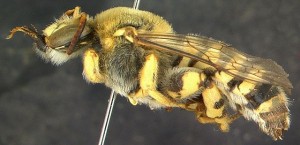I'm not especially knowledgeable about farming. Irrigation? That I know a little bit about. Crops and animal husbandry? Much less. Every now and then, I do run across something really interesting. In this case: the Mayan stingless bee.
 The stingless bees, also known as meliponines, are frequently kept in homes as pets. The Central American varieties bred by the Maya are kept in hollow logs with ceramic caps at either end that can be removed to gather honey. They are still kept this way today, in the same way they have been for countless centuries. The hives are often passed down between generations, and it’s common for hives to last 80 years.
The stingless bees, also known as meliponines, are frequently kept in homes as pets. The Central American varieties bred by the Maya are kept in hollow logs with ceramic caps at either end that can be removed to gather honey. They are still kept this way today, in the same way they have been for countless centuries. The hives are often passed down between generations, and it’s common for hives to last 80 years.
They have more uses than just as pets or to make honey. They're also used for religious purposes. Beekeepers would place the hives near certain hallucinogenic flowers, so that the honey made from them kept some of those properties, which were then turned into a sort of honey wine used in ritual practices. I reckon that there's a lot less falling asleep in church there.
Metalworkers also frequently kept bees in Central America in order to use their wax for lost-wax casting. Lost wax casting involves the creation of a wax model, followed by the creation of a mould and then a hollow wax model, after which the model is covered in a more durable material and filled with molten metal. (Yep: I've got a slightly shaky grasp on it.)
Central America isn't the only center of stingless bee cultivation. Brazil and Australia are also involved.
Unfortunately, the cultivation of stingless bees in Central America has been dropping away in favor of Africanized bees (sometime called killer bees, which is actually inaccurate; you're more likely to be hit by lightning than killed by Africanized bees), who produce much larger amounts of honey. One of the major downsides of this is that Africanized bees neglect a number of local flowers, which results in many local plants not getting fertilized.